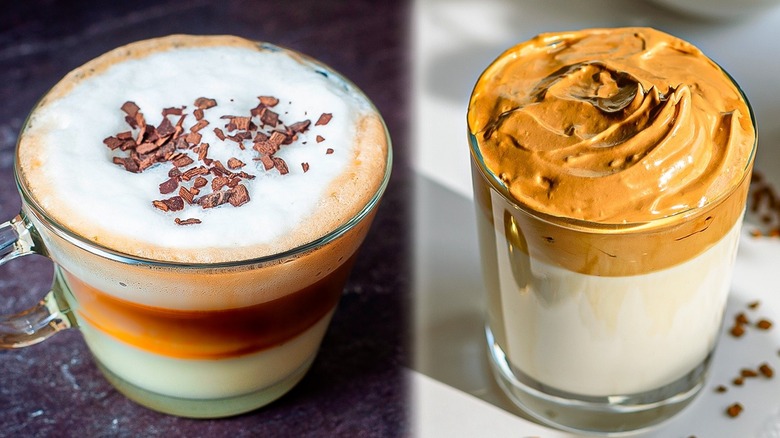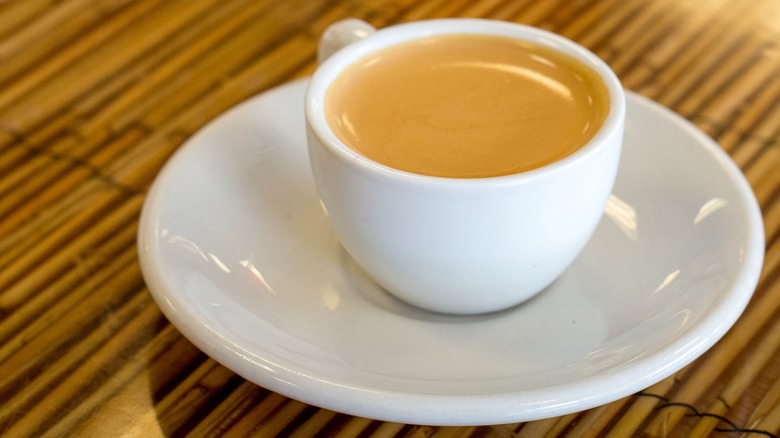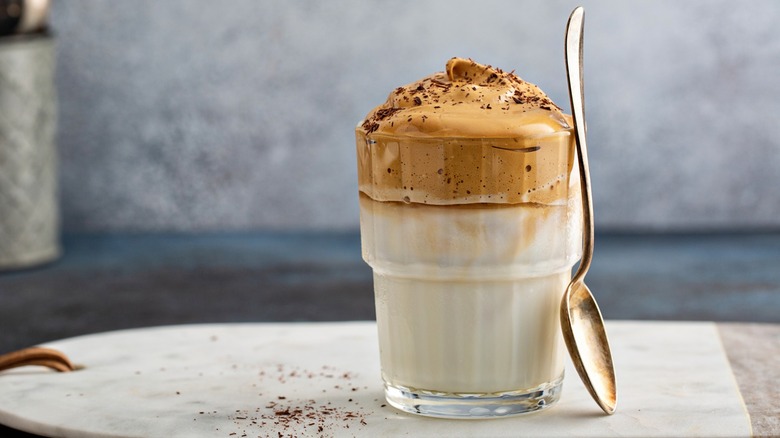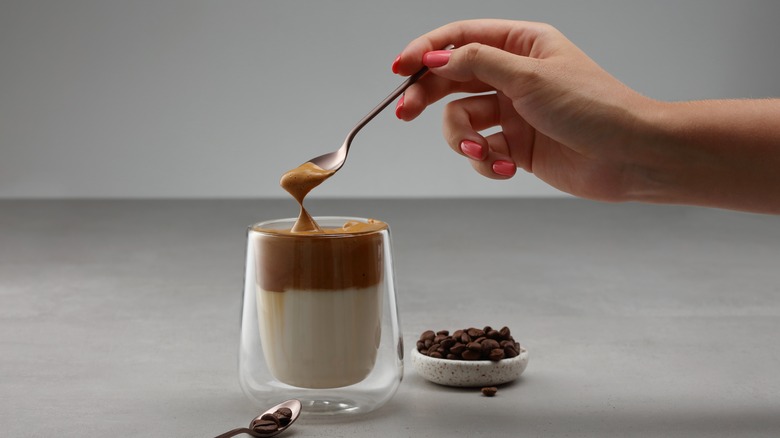Café Cubano Vs. Dalgona: What's The Difference?
While there are many different coffee brewing methods out there, most people reach for either an espresso-based beverage or a brewed coffee. After it's prepared, the next question is whether to drink it straight or with sugar. And while there's nothing wrong with simply stirring in a spoonful of sugar or coffee sweetener, there are plenty of more creative ways to add a sweet essence to your coffee. Take the café Cubano and dalgona, which are both crafted using a whipping process to create a sugary, foamy drink.
Though they hail from different continents, the two drinks' reliance on a similar process evinces coffee's global nature. By sampling such varying — yet also parallel — styles around the world, I've been amazed by the shared human experience of drinking a brew. Most of us consume similarly prepared joe from a globalized network of coffee producers. However, there are many different types of coffee drinks, with regional techniques lending an impressive cultural breadth. So, let's dive into the differences between these two delicious sugar-based coffee styles.
What is a café Cubano?
As its name suggests, the café Cubano hails from Cuba, where it's been prepared for decades. Prior to the Cuban Revolution in 1959, the island nation was an abundant coffee producer, which led to ubiquitous domestic coffee consumption. In addition, sugarcane agriculture was the country's other major industry; hence, the drink melded the two readily accessible crops. The coffee style continues to be popular on the island, but it's also become prevalent in Miami among the Cuban diaspora.
Traditionally, preparing a café Cubano starts by brewing dark-roasted beans in a moka pot, although some renditions use espresso. After the rapid decline of Cuban coffee production, most people substituted inexpensive robusta beans sourced from Latin America. However, today, baristas are employing more aromatic, expensive coffee beans for the drink. While brewing the bold coffee, several spoonfuls of unprocessed — and flavorful — demerara sugar or brown sugar are added to a cup. Some of the finished coffee is then poured into the vessel and vigorously stirred.
This method creates the café Cubano's iconic sweet foam — or espuma — which is subsequently ladled atop the rest of the coffee. The drink is usually served in an espresso cup, although larger-volume renditions are common, too. Prepared both in cafés and at home, café Cubanos are typically enjoyed convivially among family and friends rather than as a functional pick-me-up. Its sweet yet bold coffee flavor is a delicious caffeine hit for any occasion.
What is dalgona coffee?
During the COVID-19 Pandemic, you may have seen the milkshake-like dalgona coffee on your social media feed. The ultra-frothy beverage relies on three easily accessible components: instant coffee, sugar, and water, all mixed together in equal parts. Its magic is in manual exertion, as it requires up to 10 minutes of vigorous stirring to recreate the same scientific process used to make a meringue. Once frothed to completion, the result is served in a fluffy layer over ice and milk.
While it may be tempting to modify the drink — like chef Alton Brown using espresso powder to craft dalgonas – the simple instant packets create the foamiest result. The processed coffee type has less fat than standard coffee beans, which further enables its emulsion. Dalgona coffee's immediate appeal lies in its wondrous texture despite its relatively straightforward assembly. As a result of its accessibility, it possesses less of a single cultural affiliation and is instead known by a multitude of different monikers.
Its most recent trend came from South Korean media, which reported on the technique after exposure in a Macau-based café. However, a similar recipe has been enjoyed across South Asia for decades, as well as in Libya and Greece, where it's known as a frappé. Popular in coffee cultures that use instant packets, dalgona's whimsical appeal is starting to spread worldwide.
Café Cubano and dalgona coffee offer differing flavors and cultural contexts
While both are prepared by whipping coffee with sugar, the café Cubano and dalgona offer two very different experiences. The dalgona is a light and fluffy beverage that dissolves on the tongue. It doesn't have a dominant coffee flavor, and it's served either at room temperature or iced, which lends it a smoother quality.
Conversely, the café Cubano boasts strong, pungent notes, underlaid by a dense texture. Both the specific sugar and coffee used produce a more robust flavor, which makes the drink take on a more distinctive character. Combined with its singular cultural affiliation — interlinked with Cuban hospitality and agricultural production — the beverage has more identifiable origins.
Its area of consumption is more limited to Cuba and areas of the country's diaspora. Meanwhile, dalgona coffee is enjoyed across continents, with no clear lineage of development. That's not to say that one beverage is tastier than the other — both offer their own charismatic appeal. However, delineating their origins and flavor showcases what makes them so unique.



